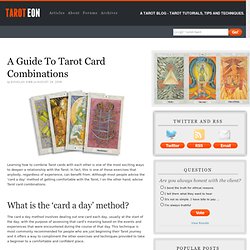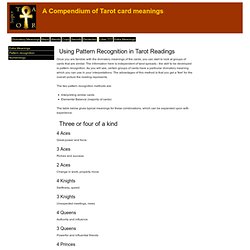

Learn Tarot Cards for Free - Lesson 1.2. 78 cards of pure magic, an overview of the Tarot cards Before we start here are some hints on how to treat and keep your Tarot cards: Spend as much time as you can practicing or meditating with them, or at least handle them regularly, especially during the course.

To avoid the cards absorbing disturbing vibrations or energies wrap them in a black cloth, silk if you can afford it, and put the wrapped cards in a box. Treat your cards gently and with respect and it is recommended that you don’t allow others to use your own deck. You will need at least 2 to 3 hours (or more) for this first lesson so start it when you know you can be undisturbed for that amount of time.
In order to begin you will need to be relaxed and calm, perhaps have some gentle instrumental music playing or incense burning - whatever helps you to relax. The very first thing I am going to ask you to do is a practical exercise for which you will need your Tarot deck and a writing pad or paper and a pen. Escuela Superior de Tarot. Mary K. Greer's Tarot Blog. Techniques And Methods For Learning Tarot Card Combinations. Learning how to combine Tarot cards with each other is one of the most exciting ways to deepen a relationship with the Tarot.

In fact, this is one of those exercises that anybody, regardless of experience, can benefit from. Although most people advise the ‘card a day’ method of getting comfortable with the Tarot, I on the other hand, advise Tarot card combinations. What is the ‘card a day’ method? The card a day method involves dealing out one card each day, usually at the start of the day, with the purpose of assessing that card’s meaning based on the events and experiences that were encountered during the course of that day. This technique is most commonly recommended for people who are just beginning their Tarot journey and it offers a way to compliment the other exercises and techniques provided to take a beginner to a comfortable and confident place.
Why I don’t encourage it! Let’s look at this a bit further: Groups of tarot cards in a reading. Once you are familiar with the divinatory meanings of the cards, you can start to look at groups of cards that are similar.

The information here is independent of tarot spreads - the skill to be developed is pattern recognition. As you will see, certain groups of cards have a particular divinatory meaning which you can use in your interpretations. The advantages of this method is that you get a 'feel' for the overall picture the reading represents. The two pattern recognition methods are: Interpreting similar cards Elemental Balance (majority of cards) The table below gives typical meanings for these combinations, which can be expanded upon with experience. Three or four of a kind 4 Aces Great power and force 3 Aces Riches and success 2 Aces Change in work, property move 4 Knights Swiftness, speed 3 Knights Unexpected meetings, news 4 Queens Authority and influence 3 Queens Powerful and influential friends 4 Princes Meetings with the great 3 Princes.
How to Learn Tarot. In this article we’d like to discuss the teaching and learning of Tarot.

We’ll start with a few questions: if you only had ten minutes with a stranger straight off the street, who had no experience of Tarot other than perhaps having seen a few cards on Buffy the Vampire Slayer, how much do you think you could teach them? How much do you think you could learn in that time? Where would you start, and how would you go about it? These are all questions that a teacher will ask themselves about any subject, and they are ones I brought to Tarot twenty years ago when I first started teaching. It is the same set of questions that we used when writing our book, Around the Tarot in 78 Days. Whilst this certainly does not mean they are then on par with anyone who has been reading tarot for five, ten, or thirty years, we teach in this manner for a number of reasons, mainly to inoculate our students against erroneous pre-conceptions about their learning. The Court Cards are "difficult. "